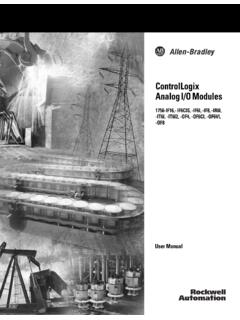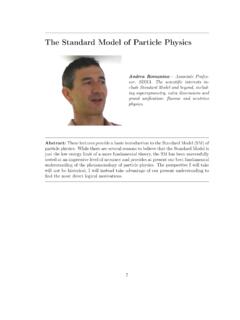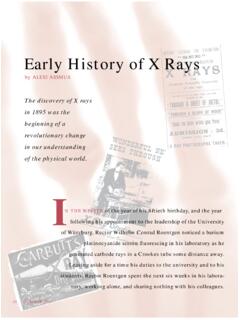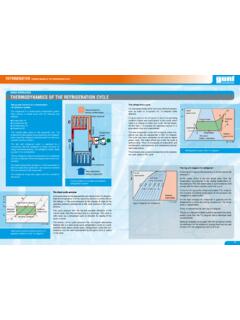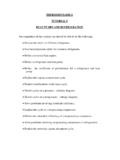Transcription of Introduction to Cryogenic Engineering - SLAC
1 Introductionto CryogenicEngineering5. Perini , G. Vandoni, T. Niinikoski, CERNI ntroductionto CryogenicEngineering MONDAY FromHistoryto Modern RefrigerationCycles(G. Perini )TUESDAY Standard Components, CryogenicDesign (G. Perini )WEDNESDAY HeatTransfer and Insulation(G. Vandoni) THURSDAY Safety, Information Resources(G. Perini )FRIDAY Applicationsof CryogenicEngineering (T. Niinikoski) IntroductionFromHistoryto Modern RefrigerationCyclesRefrigerationCycleExa mplesDay1 Whatiscryogenics?HistoryTimeofI. Newton F. Bacon (1561 -1621)But we have no coldsave such as is to be got in wintertime, or in caverns, or by application of snow and ice, [..]Andso too all natural condensations caused by cold should be investigated, in order that, their causes being known, they may be imitated by Newton 1642 -1727 Novumorganum(1620)Thethird of the seven modes [.]
2 ] relates to [..] heat andcold. And herein man's power is clearly lame on oneside. For we have the heat of fire which is infinitelymore potent and intense than the heat of the sun as it reaches us, or the warmthof animals. TimeofI. Newton Knownrefrigerationmethods refrigerationby a snow refrigerationby evaporation refrigerationby dissolvingsaltpeterin water(saltpeter= sodium nitrate NaNO3or potassium nitrate KNO3)I. Newton 1642 -1727 TimeofI. Newton R. Boyle (1627 -1691); E. Mariotte (1620 -1684)I. Newton 1642 -1727p V = constantTimeofI. Newton G. Amontons (1663 -1705)I. Newton 1642 -1727abs. zeroiceboil.+1 J. Black (1728 -1799)latent heat A. Lavoisier (1743 -1794)calorictheory S. Carnot (1824)work R. Clausius (1865) entropy W. Gibbs (1867); R. Mollier(1923)enthalpyIncentivesfor refrigerationandcryogenics Early19th century large scalerefrigerationonlyby naturalice increasingdemandfor artificialrefrigerationby thebutchers, thebrewersandlateron theindustrialistsiceharvestingrefrigerat edrailroadcar icestoragecave in BliesdahlheimIncentivesfor refrigerationandcryogenics Examplesoffirstcommercial Strathleven, equippedwithBell&Coleman air-cyclerefrigerator.
3 Firstmeatcargo transportedfromAustraliato London courtesyof"La TrobePicture Collection", State LibraryofVictoriaStandard ammoniacycle icemachine fromYork s 1892 Cailletet 1832 -1913 ThesuccessfulliquefactionofOxygenwasanno uncedatthemeeting oftheAcad mie de Sciences in Paris on December24th, 1877 independentlyby thephysicistLouis Paul Cailletet fromParis andtheprofessorRaoul Pictet fromGeneva. Cailletet s apparatus compression to 200 bar in a glass tube witha hand-operatedjack, usingwaterandmercuryfor pressure transmission pre-coolingoftheglass tube withliquidethyleneto -103 C expansion to atmospherevia a valve Brakingthecryo-barrierIIR. Pictet 1832 -1913 Pictet s apparatus production of oxygen under pressure in a retort twopre-coolingrefrigerationcycles:firsts tage SO2(-10 C)second stage CO2(-78 C) oxygenflowispre-cooledby themeansofheatexchangersandexpandsto atmospherevia a handvalveMilestonesin thehistoryofcryogenictechnology1892 Dewar -use ofsilveringandvacuum in double walledglass vessel1895 Linde andHampsonbuildair liquefierswithrecuperativeheatexchangers 1898 Dewar -liquefieshydrogen1902 Claude -use ofpiston expander1908 KamerlinghOnnes-liquefieshelium1908 Becquerel -freezesseedsandsingle cells1910use ofLOxin theproduction ofsteel1911discoveryofsuperconductivityT hermo-dynamicsThemagicofthrottling-physi cist s explanationThemagicofthrottling-physicis t s explanationT T T repulsiondominates(Coulomb) attractiondominates(gravity)
4 Joule-ThompsonidealgasGay-LussacThrottli ng-thermodynamist s explantion(andfirstlawofthermodynamics) energyconservation internal energy closed system energycontent open systemE = U+ Ekin+ EpotdQ+ dW= dE = 0E = U + pV+ Ekin+ Epot= Htranslational kinetic energyvibrational and rotational kinetic energypotential energy from intermolecular forcesinternal energy U111,,,wpum2A1A222,,,wpumH1= H2 HouseholdrefrigeratorcycleNitrogenLinde/ HampsonrefrigerationcycleQrefQWLinde andHampsonLinde liquefierHampsonliquefierC. vonLinde1842-1934 NitrogenLinde/HampsonrefrigerationcycleQ refQWQref= TdSQW= TdSClaude refrigeration cycleCarnot cycle heatremoved/ heatintroducedQW= (SA-SB) * TW Qref= (SD-SC) * TC energyconservationQW= Qref+ W and(SA-SB) = (SD-SC) W = (SA-SB) * (TW-TC) coefficient ofperformance or efficiency(index i = ideal)COPi= i= Qref/ W = TC/ (TW-TC) figureofmeritorthermodynamic(Carnot)
5 EfficiencyFOM = COPreal/ COPi= th= real/ K20K4 KCOPi, withexpansion machinein householdrefrigeratorQrefQWSummary -refrigerationrefrigerationcanbeachieved by contact witha coldersurface throttling work extractionrefrigeration can reach lower temperatures by heat recoveryCyclesBricks to builda refrigeratorA -expansion deviceB -heatregeneration/recuperationexpansionm achineheatexchangerregeneratorJ-T valveRefrigerationcycles/principleswitho utheat recoverywith recuperatorwith regeneratorthrottlingcascadesorptionJoul e ThomsonLinde HampsondilutionexpansionRanqueHilschClau deBraytonCollinsStirlingSolvayVuilleumie rGifford McMahonpulse tubeother principlesthermoelectric (cascade)magneticMixedrefrigerantcascade (MRC) refrigerator(Klimenko)isothermalcompress ionnatural gas feedLNG storageCascade refrigeratorPictet s cascadeLNGcompression Aliquidpropanecompression Bliquidethyleneliquidmethanenatural gasfeedcompression CRefrigerationcycles/principleswithouthe at recoverywith recuperatorwith regeneratorthrottlingcascadesorptionJoul e ThomsonLinde HampsondilutionexpansionRanqueHilschClau deBraytonCollinsStirlingSolvayVuilleumie rGifford McMahonpulse tubeother principlesthermoelectric (cascade)
6 MagneticJ-T coolerBy courtesy ofAir LiquideDilution refrigerator principle temperaturereductionbydilution ofHe3 in aHe4bath combined with a heat exchanger range 15mK -2 KBy courtesyofLot Oriel Group EuropeRefrigerationcycles/principleswith outheat recoverywith recuperatorwith regeneratorthrottlingcascadesorptionJoul e ThomsonLinde HampsondilutionexpansionRanqueHilschClau deBraytonCollinsStirlingSolvayVuilleumie rGifford McMahonpulse tubeother principlesthermoelectric (cascade)magneticModifiedClaude cycle refrigeratorLinde refrigeratoras usedfor theLHC18kW fin plate heatexchangerExpansion machinesExpansion machinesRefrigerationcycles/principleswi thoutheat recoverywith recuperatorwith regeneratorthrottlingcascadesorptionJoul e ThomsonLinde HampsondilutionexpansionRanqueHilschClau deBraytonCollinsStirlingSolvayVuilleumie rGifford McMahonpulse tubeother principlesthermoelectric (cascade)
7 MagneticPrincipleofregeneratorcyclesComp ressionCoolerRecuperatorRefrigerationExp ansionRegeneratorHPLPHPLPS olvay cycleGifford - McMahon cycleStirling cycleClaude cycleHPLP pulse ofregeneratorsStirling cycle refrigeratorCycle1 -Compressionin warm end2 -Displacementwarm cold3 -Expansionin cold end4 -Displacementcold warmBy courtesyofStirling CryogenicsandRefrigerationBVBy courtesyofThalesCryogenicsPrincipleofreg eneratorcyclesCompressionCoolerRecuperat orRefrigerationExpansionRegeneratorHPLPH PLPS olvay cycleGifford - McMahon cycleStirling cycleClaude cycleHPLP pulse W courtesyofSumitomo HeavyIndustriesGifford-McMahoncycle W courtesyofSumitomo HeavyIndustriesPrincipleofregeneratorcyc lesCompressionCoolerRecuperatorRefrigera tionExpansionRegeneratorHPLPHPLPS olvay cycleGifford - McMahon cycleStirling cycleClaude cycleHPLP pulse courtesyofSumitomoHeavyIndustriesRanqueH ilsch Vortex tube a vortex iscreatedby tangentialinjection accellerationofmoleculesfromexternalto internalvortex friction betweenvortices fastermoleculesofinternalvortex workon slowermoleculesofexternalvortexCommercia l [K]P [W] refrigeration principlesradiation cooling spacesimulation chambermagnetic refrigerationthermoelectric cooling -Peltier coolerBath cryostatDay2 Introductionto CryogenicEngineering MONDAY FromHistoryto Modern RefrigerationCycles(G.)
8 Perini )TUESDAY Standard Components, CryogenicDesign (G. Perini )WEDNESDAY HeatTransfer and Insulation(G. Vandoni) THURSDAY Safety, Information Resources(G. Perini )FRIDAY Applicationsof CryogenicEngineering (T. Niinikoski) RefrigerantsStandard CryostatsMaterial propertiesSpecifying a refrigeration taskManufacturing techniques and selectedhardware componentsRefrigerantsRefrigerants-state sRefrigerants-ranges1101001000He3He4H2D2 NeN2 COF2 ArO2CH4 KrXeC2H4C2H6CO2T [K]liquid/gas. (<10bar)liquid/gas. (<Tb)solid/gas. (>10mbar)Refrigerants-dataRefrigerantHe3He 4H2D2 NeN2 COF2 HeliumHeliumHydrogenDeuteriumNeonNitroge nCarbonFluorineMonoxideTemperatures [K]liqliq2-phase equilibrium at 10 point at equilibrium at 10 [K]liqliqliq2-phase equilibrium at 10 point at equilibrium at 10 existsin twomolecularspin states:orthohydrogenandparahydrogen equilibriumdependson temperature300K75% ortho 25% ortho para conversion isslow (days) andexothermQconv= -703 kJ/kgorthoor 527 kJ/kgn-H2> evaporationenthalpyof447kJ/kg specificheatandthermal conductivityofortho-andparahydrogenare significantlydifferent formsslushParticularitiesofHelium transition to a superfluid phase below the -point ( )effects.
9 Viscosity decreases by several orders of magnitude creeps up the wall thermomechanic (fountain) effect heat conductivity increases by several orders of magnitude second sounddue to the two-fluid characterStandardCryostatsCryostats -bath cryostats 1 principle direct coolingofprobe in cryogenicliquidbath operationrange: 1 -4,2 K(63 -78 K withLN2) advantages novibrations stable temperatures up-time(LHe-bath) severaldays(consumption0,5-1% perhour) disadvantages long cool-downtime(in theorderof1 hour)CourtesyofJanis Research Company, -bath cryostats 2 tails cryostat add-on for differentapplications: opticalsystemsCourtesyofJanis Research Company, -bath cryostats 3 ProbeZwischenrauminterspaceprobe anticryostata)evacuatedinterspaceprobes canbeexchangedwhilecryostat remainscoldb)interspacefloodedwithcontac t gasoperation-thetemperaturecontrol isachievedwitha heaterin theprobe supportCryostats -evaporationcryostats 1 principle A smallflowofcryogenisevaporatedandcoolsth eprobe operationrange indirect in contact gasshown)orprobe in Scientific Products -evaporationcryostats 2 direct submergedin theevaporatedhelium/nitrogenCourtesyofJa nis Research Company, -evaporationcryostats 3 withoutliquidcryogenbaths advantages compact lowcost flexible orientation fastcool-down(in theorderof10 minutes) disadvantages highconsumption( ,5l LHe/h)
10 Temperature control close to boilingpoint difficultCourtesyofJanis Research Company, -overallsystemCourtesyofCryoVacGmbH & Co KGCryostats -refrigeratorcryostatsCourtesyofCRYO Industries of America, Inc. principles operationrange 4,5 -300K advantages compact nocryogenicliquids lowoperationcosts highautonomy flexible orientation disadvantages highinvestmentcost somecancreatevibrationsSpecificationWhat to specify? Refrigerationtaskandoperation conditionsrefrigerationobjectdimensions, operationtemperatureandcoolingprinciple, cool-downandwarm-upconditions Minimum requirementscapacities, functions, materials, redundan-cies, measurementpoints andprecision, automationdegree Installation andenvironmentalconditionsinfrastructure (powersupply, cooling, comp. air), accessibility, crane, environ-ment(vibrations, magneticfield, radiation)emissions(noise, vibrations, gasemission) Interfacesinfrastructure (gasrecovery, coolingwater, instrument air, energy), controls Qualityrequirements Documentationdrawings, design calculations, diagrammes, manuals, certificates, maintenance schedule, safetyanalysis-paperformor computer readableSpecification-typicalqualityrequ irements Materials materialcertificates Joiningtechniques requirementsfor





